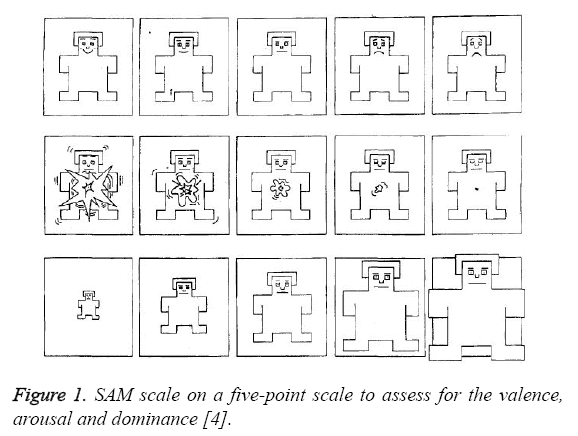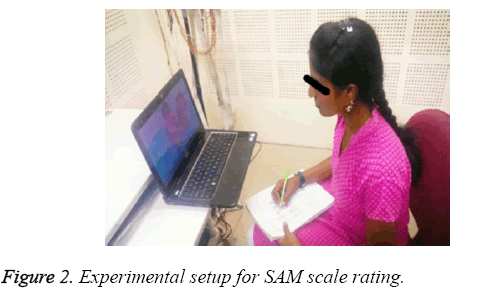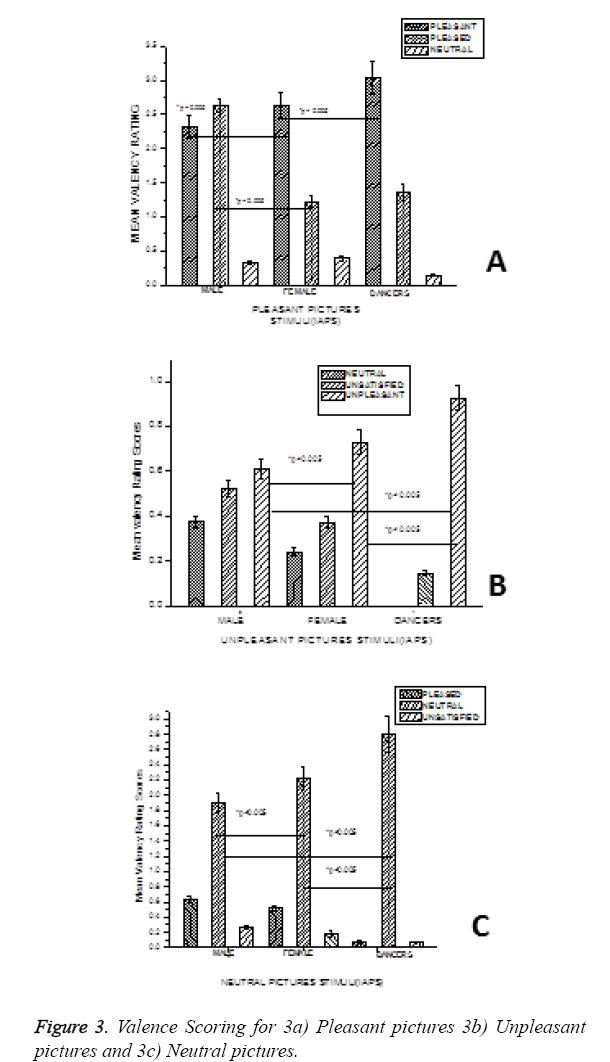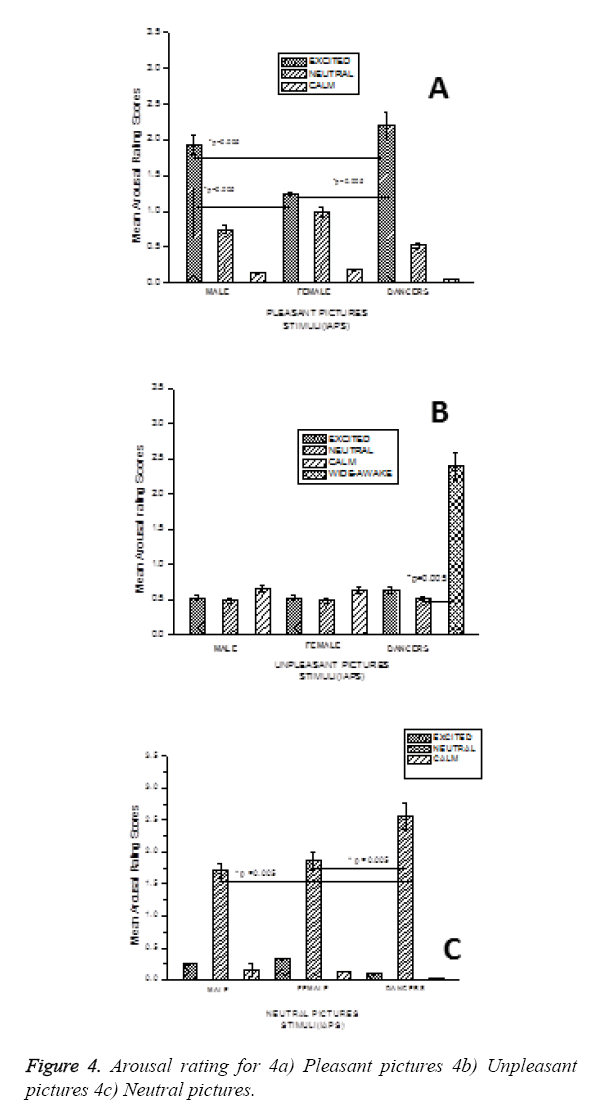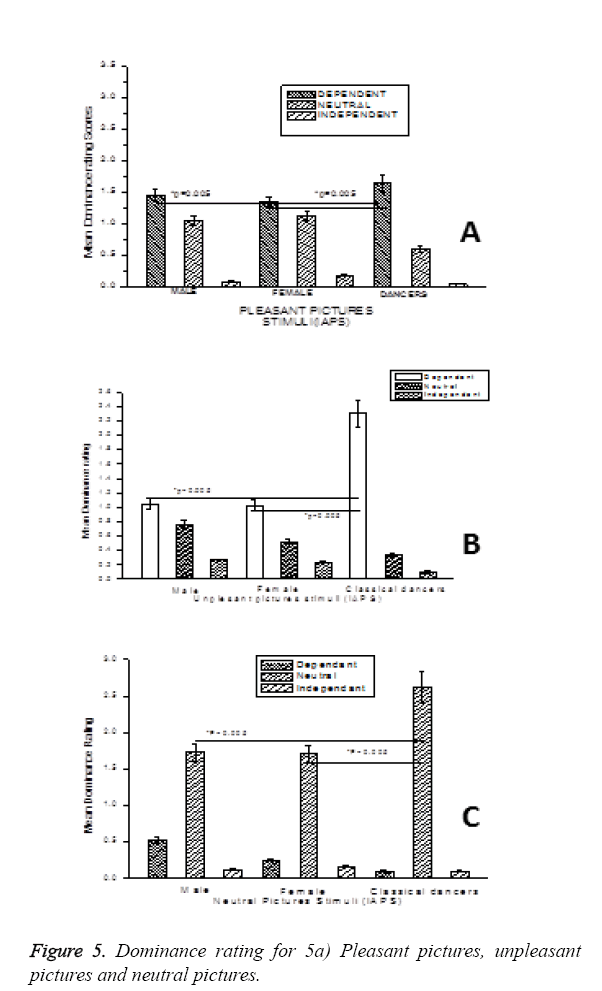Research Article - Biomedical Research (2017) Complex World of Neuroscience
Emotion analysis using SAM (Self-Assessment Manikin) scale
B Geethanjali1,2, K Adalarasu3*, A Hemapraba1, S Pravin Kumar1, R Rajasekeran21Department of Biomedical Engineering, SSN College of Engineering, Chennai 603110, India
2Biomedical Engineering Division, SBST, VIT University Vellore, India
3Department of ECE, PSNA College of Engineering and Technology, Dindigul 624622, India
- *Corresponding Author:
- K Adalarasu
Department of ECE
PSNA College of Engineering and Technology, India
E-mail: adalarasu@psnacet.edu.in
Accepted date: May 10, 2016
Abstract
Background: Emotions are collective functional behaviors and action dispositions which has significant effects in our perception, thinking and behavior. The aim of our study is to detect and recognize the human emotion using SAM (Self-Assessment Manikin) rating. The objective of this study is to find the emotions of south Indian subjects and the classical dancers in addition to determine whether the perceived emotions are the same. Methods: A strong stimulus is need for inducing an emotion. Hence International Affective Picture System (IAPS) developed by the National Institute of Mental Health Center for the Study of Emotion and Attention at the University of Florida was used in our study. Fifty five subjects participated in the experiment (20 Males, 20 Females, and 15 Classical dancers). In this present study, a distinct attempt has been made by including the classical dancers among the group of participants. The perceived emotions are recorded in three dimensional spaces (valence, arousal, and dominance domain) for the Indian subjects using Self-Assessment Manikin Scale (SAM). Results: The male perceived the pleasant pictures in valence space as pleased and in arousal space it was excited (rs=0.511) in dominance space as dependant (rs=0.301). while female (rs=0.405) and classical dancers (rs=0.551) perceived the pleasant pictures in valence space as pleasant and in arousal space it was excited, as well as in dominance space as dependant (rs=0.202), (rs=0.210). The unpleasant pictures were rated as unpleasant by all in valance space whereas in arousal space female and male rated in arousal space rated as was dull (rs=0.222) and classical dancers as wide awake (rs=0.480). Whereas female (rs=0.170) and classical dancers (rs=0.332) rated dependant in dominance space. The neutral pictures were perceived as neutral by males, females and classical dancers. Conclusion: As emotion is subjective and it varies across culture, the valence scoring is same for gender to pleasant, unpleasant and neutral stimuli. The variations were noted in arousal and dominance space. The study concludes classical dancers perceived emotion for all the three categories of stimulus (pleasant/unpleasant/neutral) better when compared with female and male.
Keywords
Valence, Arousal, Dominance, Pleasant, Unpleasant, Neutral
Introduction
Emotion is a subjective and conscious occurrence which is illustrated mainly through psycho physiological expressions and biological reactions. Moreover, emotions are complex state of feeling that influences our performance. Various stimuli were used to study the perceived and induced emotions. The induced emotions were often reflected as the change in physiological signals. Hockenbury and Hockenbury stated emotion as a composite psychological state that engages subjective experience, a physiological response, and an expressive reaction [1]. The most common inductions in the psycho-physiological study of emotion can be roughly classified as involving perception, imagination, anticipation, or action. The emotion assessments were done by analyzing the user’s expressions and physiological signals [2]. The subjective perception in response to stimulus was measured using selfrated questionnaires.
Justlin et al. and Bradley and Lang used Self-Assessment Manikin (SAM) scale to evaluate the pleasure, arousal and dominance in one scale. Selecting an appropriate stimulus becomes most important to induce an emotion [3,4]. Lang et al. and Bradley and Lang used International Affective Picture System (IAPS) and International Affective Digitized Sounds (IADS) as a stimulus to induce emotion and the changes in heart rate were measured [5,6]. The emotions were recorded in three dimensional spaces (valence, arousal, and dominance domain) for the Indian subjects using Self-Assessment Manikin Scale (SAM). In Western culture, women perceive more emotions compared to men and in particular more reactive to unpleasant scenes, especially those are aversive and traumatic. Also based on the evidence, women tend to report experiencing more happiness and joy. An emotion is an essential part of the classical dance performance. In classical dance rasa is in relation to human mind and the people who perform classical dance feel the mind and express the feeling subsequently leading to facial expressions. Moreover rasa is the backbone of classical dance so its hypnotized experienced classical dancers would perceive the emotion better than nonclassical dancers.
Fisher et al. focused on the expressive components as emotional expressivity replicates the degree of individual’s apparent exposition of their emotion [7,8] and their results conclude women are more expressive than men. Based on previous researchers’ findings the study hypothesis the people who are more expressive will elicit enhanced emotion when compared with non-expressive participants. In the current work apart from gender difference (male/female) classical dancers were considered. Classical dancers are multi-dimensional performers where their body movements and facial expressions convey their perceived emotion and are more expressive in their emotions when compared to non-classical dancers. The uniqueness of our study includes the comparison of the perceived emotion between gender (male/female) and classical dancers and to determine whether there is cultural differences influence in the perceived emotion in south Indian population when compared with western population.
Materials and Methods
Subject selection
Participants pursuing Engineering at varies Institutions, Chennai were recruited for this study. In our study, 55 participants were selected with equal number of men (20), women (20), and classical dancers (15, all of them were female). All the participants had normal vision. Classical dancers with five years of experience in dancing were chosen for this study as they perceive emotion better when compared to beginners. The average age of the participants was about 18-21 years. The subjects were healthy and not on any medication. The participants volunteered for this study based on their own interest. It had been informed to the subjects that they can halt the test at any time when they feel apprehensive during the test. The experiment was conducted in the morning in a sound proof room, where participants sat in a comfortable chair. All volunteers also read and signed an informed consent before participating.
Subjective measures (SAM Scale)
The Self-Assessment Manikin (SAM) [4,5] five pointer scale was used in the current study to directly measure the pleasure, arousal, and dominance related in response to three categories of IAPS images. Figure 1 below shows the SAM figure with pleasure, arousal, and dominance scales on the top, middle, and bottom rows, respectively.
Figure 1: SAM scale on a five-point scale to assess for the valence, arousal and dominance [4].
The scoring has been done using the Self-Assessment Manikin (SAM) [4,5], which measures the pleasure, arousal, and dominance associated with viewing each picture (Table 1). The pleasure scale shows SAM smiling at right end and unhappiness at the other. Excited figure at the right end of the scale and a calm figure at the other represent arousal. The dominance scale represents dependent as a small figure and independent with a large figure. Subjects were asked to make a mark on the circle provided below each of the emotion figure.
| Scale | Valence rating | Arousal rating | Dominance rating |
|---|---|---|---|
| 5 | Pleasant | Excited | Dependent |
| 4 | Pleased | Wide-awake | Powerlessness |
| 3 | Neutral | Neutral | Neutral |
| 2 | Unsatisfied | Dull | Powerful |
| 1 | Unpleasant | Calm | Independent |
Table 1: SAM scale scoring.
Stimuli selection
An independent sample design was used which consists of three different groups male, female and classical dancers and they were asked to rate their perceived emotion for each stimulus that was presented to them using SAM scale. The stimulus from the IAPS database of various categories (Pleasant/unpleasant/neutral) were used and presented for the first time, which means the participants were not aware of the stimulus prior to the experiment. The selected images in all the three categories were not presented in any order they were randomly shuffled. The erotic picture stimuli from the IAPS database were not used owing to cultural limitations.
Experimental protocol
Each experiment session lasted for 27 minutes Table 2, a baseline of 30 sec, warning for 2 sec (30 images*2 sec=60sec) indicates the beginning of the image presentation and this was given for the presentation of all the 30 images, viewing the images for 6 sec (30 images*6 sec=180 sec), and rating for 15 seconds (30 images*15 sec=450 sec, followed by resting for 30 sec ( 30 images*30 sec=900 sec). The baseline and the resting period is also a silence period (non-viewing) and the participants were asked to close their eyes during both the baseline and resting periods. A set of 30 pictures have been allotted for each of the individuals. The participants are made to sit comfortably on the chair in a sound proof room as shown in Figure 2 and the experiment protocol was clearly explained before the commencement of the experiment. The participants were instructed to concentrate only on the displayed pictures.
| Baseline | Warning (indicating the beginning ) | Viewing the picture (pleasant/unpleasant/neutral) | Rating each viewed picture | Resting (after viewing each picture) |
|---|---|---|---|---|
| 30 seconds | 2 seconds | 6 seconds | 15 seconds | 30 seconds |
Table 2: Experimental protocol.
Statistical analysis
The subjective ratings for the IAPS pictures were not normally distributed. Therefore a non-parametric test was performed (N=55). The IAPS pictures (stimulus to induce emotion for all the three categories) were considered as independent variables, the subjective rating for valence, arousal and dominance were considered as dependant variables. The correlation analyses were carried out using Spearman rank-order correlation test for measuring the correlation between male/female/classical dancers in the perceived emotion. The Mann-Whitney U test was conducted to check the presence of significant difference between all the three groups. The significant level was set at 0.05 and the analysis was performed using IBM SPSS Statistics for Windows, version 20.0 (Armonk, NY: IBM Corp).
Results
Correlation within subjects
The correlation between valence/arousal and dominance within subjects (male/female/classical dancers) was calculated using spearman’s correlation. The male perceived the pleasant pictures in valence space as pleasant (rs=1) and in arousal space as excited (rs=0.511) and in dominance space as dependant (rs=0.301). The male perceived the pleasant pictures as pleasant, excited and dependant. The male perceived the unpleasant pictures in valence space as unpleasant (rs=1) in arousal space it was dull (rs=0.222) and in dominance space as independent (rs=0.166). The male perceived the unpleasant pictures as unpleasant, dull and independent. The male perceived the neutral pictures in valence space as neutral (rs=1) in arousal space it was neutral (rs=0.429) and in dominance space as neutral (rs=0.375). The male perceived the neutral pictures as neutral in all the three dimensional space of emotion (Table 3).
| Category Viewing Pleasant Pictures | Male | Female | Dancers |
|---|---|---|---|
| Valence | 1.00 | 1.00 | 1.00 |
| Arousal | 0.511 | 0.405 | 0.551 |
| Dominance | 0.201 | 0.202 | 0.210 |
| Category Viewing Unpleasant Pictures | Male | Female | Dancers |
| Valence | 1.00 | 1.00 | 1.00 |
| Arousal | 0.222 | 0.237 | 0.480 |
| Dominance | 0.166 | 0.170 | 0.332 |
| Category Viewing Neural Pictures | Male | Female | Dancers |
| Valence | 1.00 | 1.00 | 1.00 |
| Arousal | 0.429 | 0.411 | 0.709 |
| Dominance | 0.375 | 0.430 | 0.706 |
Table 3: Correlation coefficient for all the three categories while viewing pictures.
The female perceived the pleasant pictures in valence space as pleasant (rs=1) in arousal space it was excited (rs=0.405) and in dominance space as dependant (rs=0.202). The female perceived the pleasant pictures as pleasant, excited and dependant. The female perceived the unpleasant pictures in valence space as unpleasant (rs=1) in arousal space it was dull (rs=0.222) and in dominance space as dependent (rs=0.170). The female perceived the unpleasant pictures as unpleasant, dull and dependent. The female perceived the neutral pictures in valence space as neutral (rs=1) in arousal space it was neutral (rs=0.411) and in dominance space as neutral (rs=0.430). The female perceived the neutral pictures as neutral in all the three dimensional space of emotion. The classical dancers perceived the pleasant pictures in valence space as pleasant (rs=1) in arousal space it was excited (rs=0.551) and in dominance space as dependant (rs=0.210). The classical perceived the pleasant pictures as pleasant, excited and dependant. The classical dancers perceived the unpleasant pictures in valence space as unpleasant (rs=1) in arousal space it was wide awake (rs=0.480) and in dominance space as dependent (rs=0.332). The classical dancers perceived the unpleasant pictures as unpleasant, wide awake and dependent. The female perceived the neutral pictures in valence space as neutral (rs=1) in arousal space it was neutral (rs=0.709) and in dominance space as neutral (rs=0.706). The classical dancers perceived the neutral pictures as neutral in all the three dimensional space of emotion.
Comparison valence rating scores between groups (male/ female and classical dancers): The participants rated the valence/arousal/dominance space of emotion using SAM on five pointer ordered scale where the responder choose one option (intensity) from valence space (Pleasant, Pleased, Neutral, Unsatisfied, Unpleasant) arousal space (Excited, Wide-awake, Neutral, Dull, Calm) and dominance space (Dependent, Powerlessness, Neutral, Powerful, Independent) for rating three categories (pleasant/unpleasant and neutral) of pictures. The Mann-Whitney U test was performed to determine the difference in each scoring category. For three independent groups (male/female/classical dancers) which are not normally distributed.
The Figure 3 shows the mean valence rating for pleasant, unpleasant and neutral pictures for male/female and classical dancers. Within groups, the male rated pleasant pictures as pleased but female and classical dancers rated pleasant pictures as pleasant. Even though both female and classical dancers rated pleasant pictures as pleasant the scoring rate was significantly high (p=0.005) for classical dancers when compared to female. The pleasant scoring rate was significantly low (p=0.005) for male when compared to female and classical dancers as shown in Figure 3a. The male, female and classical dancers rated unpleasant pictures as unpleasant. Even though they all rated the same category, the mean valence score for unpleasant was significantly high (p=0.005) for classical dancers when compared with female and significantly low (p=0.005) for male when compared to classical dancers as shown in Figure 3b. Again male, female and classical dancers rated neutral pictures as neutral. Even though they all rated the same category, the mean valence score for neutral was significantly high (p=0.005) for classical dancers when compared with female and significantly low (p=0.005) for male when compared to classical dancers as shown in Figure 3c.
Arousal rating for pleasant, unpleasant and neutral pictures stimuli: When the arousal space was compared within groups, the male, female and classical dancers rated pleasant pictures as excited. Even though they rated excited their mean arousal score for excited was significantly high (p=0.005) for classical dancers when compared with male and the scoring rate was significantly low (p=0.005) for female when compared to male and classical dancers shown in Figure 4a while the arousal space were compared for unpleasant pictures, there was no significant difference in male and female scoring , the mean scoring rate for various categories like excited, neutral and calm were equally distributed and no one rated wide awake category . Whereas classical dancers mean arousal rating for wide awake category was significantly high (p=0.005) when compared with neutral shown in Figure 4b. Again male, female and classical dancers in arousal space rated neutral pictures as neutral. Even though they all rated the same intensity, the mean valence score for neutral was significantly high (p=0.005) for classical dancers when compared with female and the mean scoring rate was significantly low (p=0.005) for male when compared to classical dancers and female shown in Figure 4c.
Dominance rating for pleasant, unpleasant and neutral pictures stimuli: The Figure 5 shows the mean Dominance rating for pleasant, unpleasant and neutral pictures for male/ female and classical dancers When the dominance space were compared within groups, the male, female and classical dancers rated pleasant pictures as dependant. Even though they rated dependant their mean dominance score for dependant were significantly high (p=0.005) for classical dancers when compared with male and female and there was no significant difference in scoring rate for male and female shown in Figure 5a while the dominance space was compared within groups, the male, female and classical dancers rated unpleasant pictures as dependant. Even though they rated dependant their mean dominance score for dependant was significantly high (p=0.005) for classical dancers when compared with male and female and there was no significant difference in scoring rate for male and female shown in Figure 5b. In dominance space the male, female and classical dancers rated neutral pictures as neutral. Even though they rated neutral their mean dominance score for neutral was significantly high (p=0.005) for classical dancers when compared with male and female and there was no significant difference in scoring rate for male and female shown in Figure 5c.
Discussion
The Self-Assessment Manikin (SAM) is a pictographic scale to assess emotion in three independent affective spaces which are valence, arousal and dominance. Moreover SAM scale pictorial representation being a more human like figure may direct to further reliable decision on perceived emotion [9]. Based on these researchers’ findings in order to measure the existing feeling states the current study employed five pointer SAM Self-Assessment Manikin (SAM) scale. In addition to it the perceived emotion measured using SAM Scale has the prospect to evaluate mixed emotion with less technical resource [10]. Based on these researchers’ findings the current study evaluated the perceived emotions in three dimensional spaces (valence, arousal and dominance domain) for the Indian subjects using Self-Assessment Manikin Scale (SAM). The static images from IAPS database of diverged categories of pleasant, unpleasant and neutral were utilized as stimulus to induce emotion. Caicedo and Van-Beuzekom stated while emotional occurrence is developed in time, and it’s decisive that subjective feeling should be evaluated as soon as possible [10]. Additionally, if an assessment period is extended following the stimulus occurrence it can lead to imprecise measurement. In addition to that focusing on long list of emotion stimulus could deceive for an individual’s consistent evaluation. Based on this assumption the current work focused on only less number (30) of IAPS images of various categories and in this way the experimental time could be reduced.
The gender specific perceived emotion varies across the globe and it depends on the social status apprehended by men and women in their respective countries Fischer et al. and Donges et al. concluded women have better capability to perceive and respond to positive facial emotion at repeated processing level compared to men and they demonstrate and sense added emotion than male [7,11,12]. The results in the current investigation support Donges et al. and Chaplin and Aldao [12], conclusion the female and classical dancers perceived the pleasant pictures as pleasant, whereas male perceived as pleased less intense in valence scoring although their arousal (excited) and dominance (dependant) was same. Gohier et al. reported healthy women have greater feeling to negative stimuli when compared with healthy men [13]. Gomez et al. noted women react more negatively to unpleasant stimuli when compared to male [14]. The female perceived the unpleasant pictures as unpleasant, dull and dependent and classical dancers perceived the unpleasant pictures as unpleasant, wide awake and dependent. Whereas the male perceived the unpleasant pictures as unpleasant, dull and independent. The current conclusion chains that the female and classical dancers had more feeling (dependant) for unpleasant stimulus whereas male were perceived it as self-determining [13,14]. However, they all perceived the neutral pictures as neutral in all the three dimensional space of emotion.
A strong correlation existed in between male, female and classical dancers while preceding the valence and dominance. Whereas the arousal ratings difference between them was higher for classical dancers (0.551), high for male (0.511) and low for females (0.405) for viewing pleasant pictures. while viewing unpleasant category again the valence scoring for all the participants were same and arousal scoring were highly correlated for male and female (0.232) whereas the arousal scoring was higher for classical dancers (0.480) and this arousal scoring reflected in the dominance scoring higher for classical dancers whereas it was the same for male and female (0.170). The classical dancers rated unpleasant stimuli as unpleasant/wide awake and dependant, while male and female participants rated as unpleasant/calm and dependant. There was no variation in valence and dominance rating but the intensity of arousal rating was high for classical dancers which indicate they are more reactive to unpleasant stimuli when compared male and female. The valence scoring was highly correlated for male, female and classical dancers for neutral pictures. But when arousal and dominance scores were different for classical dancers they perceived neutral pictures as high arousal (0.709) and high dominance (0.706) whereas male and female perceived as low arousal but the dominance varied between male and female when viewing neutral category pictures. Gard and Kring and McManis et al. stated that women in western society are more emotional and reactive to unpleasant scenes when compared to men [15,16]. Kring and Gordon concluded women are more expressive in sadness, anger, disgust, fear, surprise, anger, and happiness-smiling when compared to men [8]. Our current study supports their findings as the classical dancers recruited for this work were all females, and their responsive to unpleasant and neural stimuli arousal scoring rate were much higher than female (non classical dancers) and male.
An emotion is an essential part of the classical dance performance. In classical dance rasa is in relation with the human mind and the people who perform classical dance feel the mind and express the feeling which subsequently leads to facial expressions. C. S. Srinivas 2014 stated that classical dancers are trained for three types of emotions (bhavas) they were static emotion, transitory and responsive emotions [17]. As the current study focused on classical dancers who were trained in these emotion they were more responsive to the perceived emotion for the entire three category of picture (pleasant/unpleasant and neutral). The current study had a limitation of using fifty five participants where 20 males, 20 females, and 15 classical dancers perhaps if greater than 30 sample in each category (male/female/classical dancers) were recruited it would have been a good estimate.
Conclusion
In the three dimensional emotional affective spaces the valence scoring intensity for female and classical dancers were same for pleasant pictures whereas male rated as pleased, even though their arousal (excited) and dominance (dependant) was same. Whereas no changes were noted in valence scoring intended for male, female and classical dancers while perceiving unpleasant and neutral. The male and female perceived unpleasant pictures in arousal space as dull whereas classical dancers as wide awake. But in the dominance space the female and classical dancers rated the unpleasant pictures as dependant and male as independent which indicates female and classical dancers are more reactive to unlikeable situation when compared with male. As emotion is subjective and it varies across culture, the valence scoring is same for gender to pleasant, unpleasant and neutral stimuli. The variations were noted in arousal and dominance space. The study concludes that classical dancers perceived emotion for all the three categories of stimulus (pleasant/unpleasant/neutral) better when compared with female and male. In order to make the results more conclusive, in the future work the sample size would be increased in each grouping and an increase in the number of stimulus in various categories like positive valence /low and high arousal and negative valence low and high arousal pictures would be considered.
Acknowledgements
The authors thank NIMH Center for the Study of Emotion and Attention at the University of Florida for providing the IAPS pictures. The researcher also would like to thank all the volunteers for their time and effort to make this study possible. The authors would like to thank all the unknown and anonymous reviewers for their invaluable comments and guidance to improve this study.
References
- Hockenbury DH, Hockenbury SE. Discovering psychology. Macmillan, 2010.
- Koelstra S, Mühl C, Soleymani M, Yazdani A, Lee JS, Ebrahimi T, Pun T, Nijholt A, Patras I. DEAP: A Database for Emotion Analysis Using Physiological Signals. IEEE Trans. Affective Computing 2012; 3: 18-31.
- Juslin PN, Laukka P. Expression, perception, and induction of musical emotions: A review and a questionnaire study of everyday listening. J New Music Res 2004; 33: 217-238.
- Bradley MM, Lang PJ. Measuring emotion: the self-assessment manikin and the semantic differential. J Behavior Therapy Exp Psychiatry 1994; 25: 49-59.
- Lang PJ, Bradley MM, Cuthbert BN. International affective picture system (IAPS): Instruction manual and affective ratings. The center for research in psychophysiology, University of Florida, 1999.
- Bradley MM, Codispoti M, Sabatinelli D, Lang PJ. Emotion and motivation II: sex differences in picture processing. Emotion 2001; 1: 300.
- Fischer AH, Rodriguez Mosquera PM, van Vianen AEM, Manstead ASR. Gender and Culture Differences in Emotion. Emotion 2004.
- Kring AM, Gordon AH. Sex Differences in Emotion: Expression, Experience, and Physiology. J Personality Social Psychol 1998; 74: 686-703.
- Obaid M, Dünser A, Moltchanova E, Cummings D, Wagner J, Bartneck C. LEGO Pictorial Scales for Assessing Affective Responses.Proceedings of the IFIP TC.13 International Conference on Human-Computer Interaction - INTERACT 2015, Bamberg pp. 263-280.
- Caicedo DG, Van Beuzekom M. How do you feel? An assessment of existing tools for the measurement of emotions and their application in consumer products research. Delft University of Technology. Department of Industrial Design, 2006.
- Donges US, Kersting A, Suslow T. Women's greater ability to perceive happy facial emotion automatically: gender differences in affective priming. PLoS One 2012; 7: e41745.
- Chaplin TM, Aldao A. Gender differences in emotion expression in children: A meta-analytic review. Psychological Bulletin 2013; 139: 735-765.
- Gohier B, Senior C, Brittain PJ, Lounes N, El-Hage W, Law V, Surguladze SA. Gender differences in the sensitivity to negative stimuli: Cross-modal affective priming study. European Psychiatry 2013; 28: 74-80.
- Gomez P, Gunten A, Danuser B. Content‐specific gender differences in emotion ratings from early to late adulthood. Scandinavian J Psychology 2013; 54: 451-458.
- Gard MG, Kring AM. Sex differences in the time course of emotion. Emotion 2007; 7: 429.
- McManis MH, Bradley MM, Berg WK, Cuthbert BN, Lang PJ. Emotional reactivity in children: Verbal, physiological, and behavioral responses to affective pictures. Psychophysiology 2001; 38: 222-231.
- Srinivas CS. Significance of Rasa and Abhinaya Techniques in Bharata’s Natyasastra. IOSR J Humanities Social Sci 2014; 19: 25-29.
